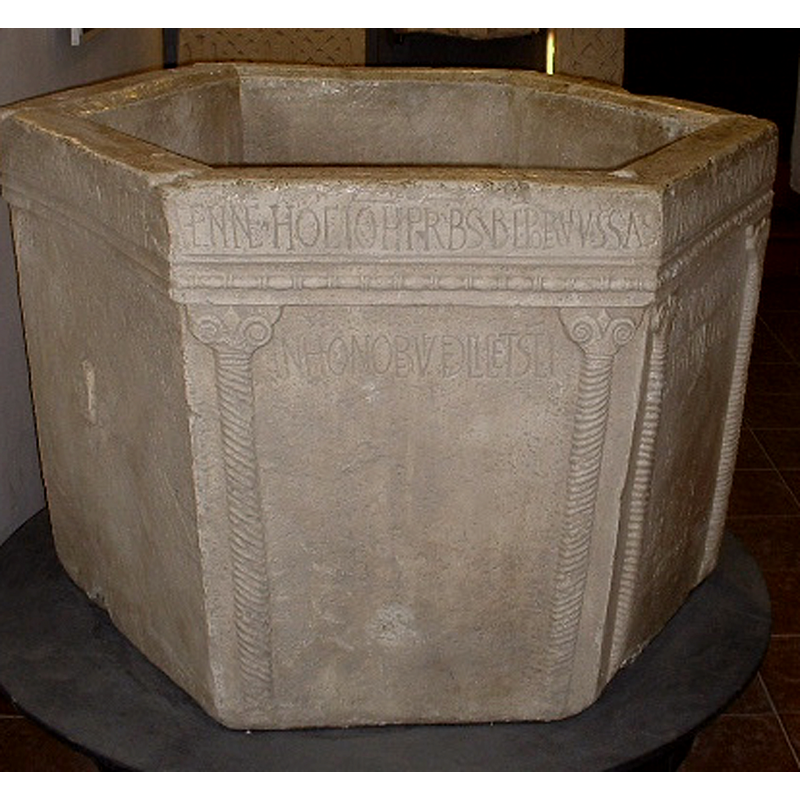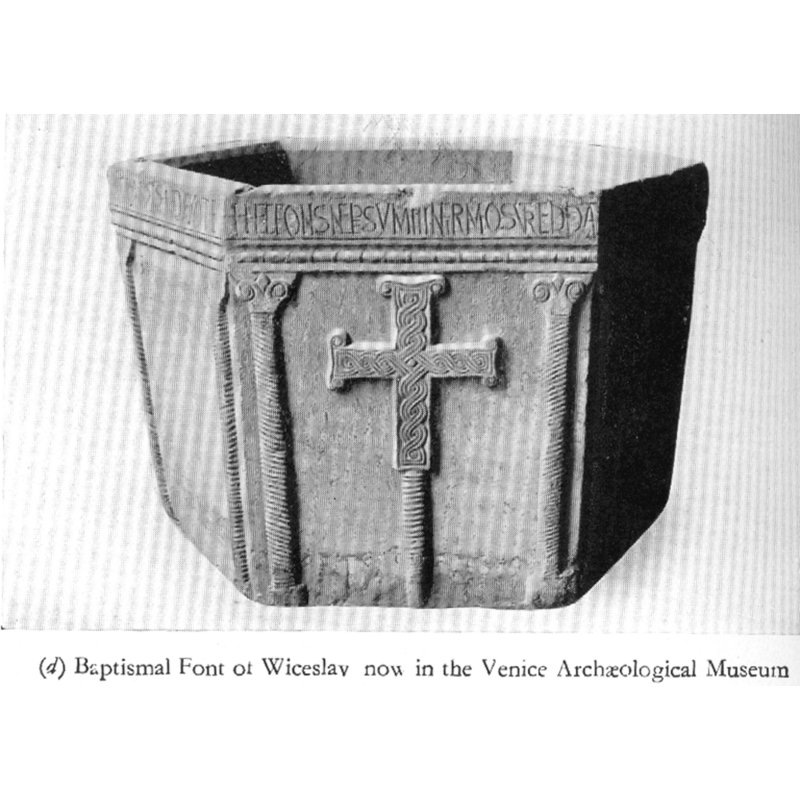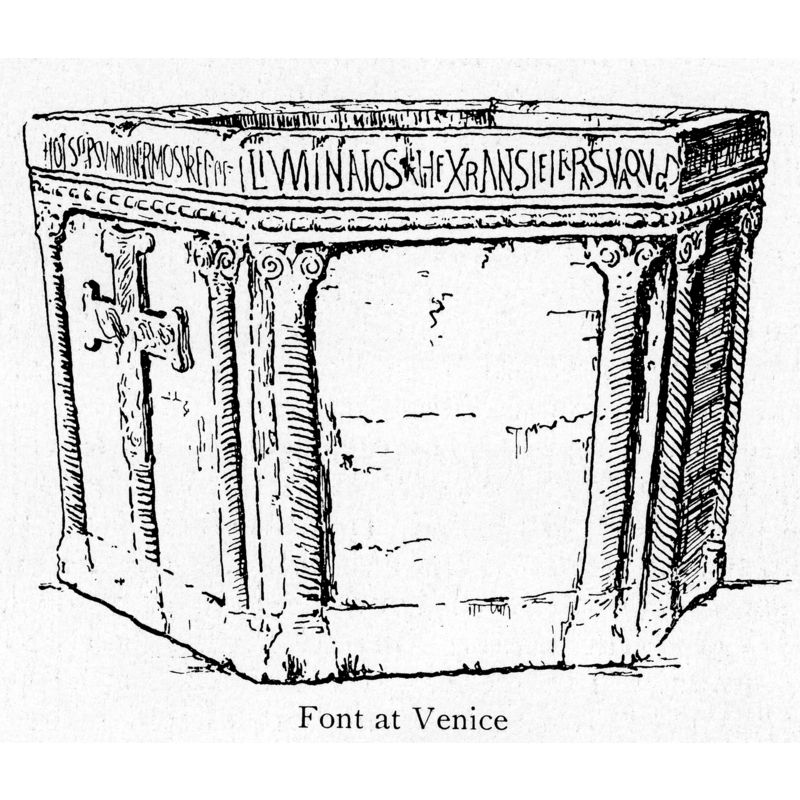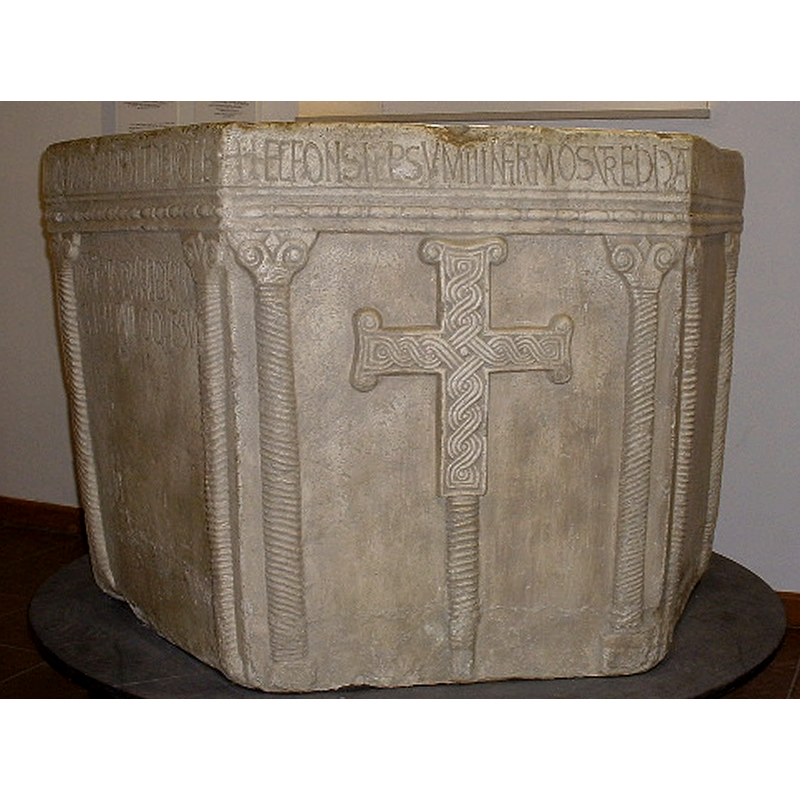Nin / Aenona / Nona

Image copyright © Leonid Maximenkov, 2002
Image and permission received from the author (e-mail of Sept. 26, 2002)
Results: 7 records
design element - architectural - column - spiral motif
inscription - partial
symbol - cross - processional cross
view of font
view of font
view of font
Scene Description: font replica, Khvar, Croatia [copy of the original font from Nin, Croatia)
Copyright Statement: Image copyright © Leonid Maximenkov, 2002
Image Source: digital photograph September 2002 by Leonid Maximenkov
Copyright Instructions: Image and permission received from the author (e-mail of Sept. 26, 2002)
view of font
Scene Description: Reproduction of the font, Khvar, Croatia [copy of the original font from Nin, Croatia)
Copyright Statement: Image copyright © Leonid Maximenkov, 2002
Image Source: digital photograph September 2002 by Leonid Maximenkov
Copyright Instructions: Image and permission received from the author (e-mail of Sept. 26, 2002)
INFORMATION
FontID: 03853NIN
Object Type: Baptismal Font1
Museum and Inventory Number: HAS museum [Museum of Croatian Archaeological Monuments]
Church/Chapel: [Said to be originally from Nin; may have never left Venice?]
Church Location: [NB: coordinates given for Split]
Country Name: Croatia
Location: Zadar
Directions to Site: Nin is located 15 kms N of Zadar, but the font is now in the HAS museum in Split [a copy exists in Nin]
Historical Region: Dalmatia
Font Location in Church: [in a museum]
Date: ca. 791-830? / ca. 875?
Century and Period: 8th - 9th century, Early Christian / Medieval
Cognate Fonts: a replica of this font in Hvar/Khvar, also in Croatia
Credit and Acknowledgements: We are grateful to Dr. Leonid Maximenkov for the images of the copy of the Nin font. We are also grateful to Pol Herman for his addiontional comments and information on this font
Church Notes: Nin was a medieval bishopric and the churchs date to the 8th-9th century
Font Notes:
Click to view
Noted and illustrated in Pantelić (2000) who argues for a date ca. 791. Hexagonal unmounted font that has been traditionally dated to the early 9th century by its inscription which gives the reference of duke Višeslav, besides the name of the priest who commissioned it, Iohannes / Ivan [cf. Inscriptions]. It was believed for a long time to be the font from the baptistery at Nin but, as Jakšic (2002) informs, recent excavation around the Church of St. Anselm in Nin by J. Boleševic and M. Kolega have turned up what may be the missing baptismal from the Nin baptistery. The sides of the font are framed at the top by the wide rim, which carries part of the inscription, and a thin line of lozenge (?) motif; at the left and right edges of each basin side, a column with capital and base, the central stem of the columns ornamented with screw-thread motif. The front side has a large processional cross, filled with three-thread braid motif while the pole of the cross has the same motif as the side columns, a screw-thread motif. The monolithic font sits directly on the ground, without a base. At the time of Bond [ca. 1908] and Strzygowski [ca. 1928] this font was still at the archaeological museum in Venice; it is now [2000] at the HAS museum [Museum of Croatian Archaeological Monuments], in Split, Croatia. (Sources: Croatia in the Early Middle Ages, 1999: 240, 241, 474, 475; Jurkovic, 2000: 226-227; Strzygowski, 1928: 23-24 and pl. VI, d). The article by Jakšic (2002) offers an interesting suggestion to solve the mistery: the Višeslav font was actually made in Venice, commissioned by a diplomat, the presbiter Iohannes, probably in the last quarter of the 9th century, to be taken to the land of 'dux Vvissasclav'; this presbiter had visited the target lands in earlier occasions; for an unknown reason this new expedition never left Venice, which might explain the re-appearance of this font at the Capuchin monastery in Giudecca, Venice, in the middle of the 19th century, carrying an inscription destined for far-away lands. The English-language catalogue of The Archaeological Museum, Zadar, for the year 2000 [BSI file] lists the Nin font as 9th-century in entry no. 41 in the section "The Middle Ages: Early Croation Exhibition (Ground floor)" -- [NB: a mould (?) copy of this font was made for, and is now [September 2002], in the town of Nin, in Croatia; a reproduction of this font is found on the island of Khvar]
A communication to BSI from Pol Herman (e-mail of 8January 2024] notes: "Prince Višeslav's baptismal font was discovered in the Korer City Museum in Venice in 1853. There is an inscription on it that testifies that it was commissioned by the priest Jovan during the time of Prince Višeslav. The inscription talks about the purpose of the baptistery so that those who are baptized in it are cleansed of sins and saved by confessing the Holy Trinity, and during the reign of Višeslav ("DVCI VVISSASCLAVO"), the priest Jovan dedicated it to St. John the Baptist. According to its stylistic features, it dates back to the end of the 8th and the beginning of the 9th century. In the paper, published in the Proceedings of the Byzantological Institute, historian Predrag Komatina examines the epigraphic characteristics of the inscriptions on the baptistery and makes assumptions that the baptistery could be attributed to the "Kotor stonemason's workshop from the time of Bishop Jovan". In the paper, the author referred to the assumptions of archaeologist Đ. Janković, who shared the same opinion about the origin of the baptistery. The late professor pointed out the epigraphic similarity of the baptistery with those decorations in the ruins of the Monastery of St. Archangel on Svetomiholjska Prevlaka near Tivat in Boka Kotorska. In this way, Janković wanted to locate the original location of the baptistery in this monastery. Which he probably did. Also, in the work, the author accepted the opinion of archaeologist M. Aleksić that this is the Serbian prince Višeslav mentioned by Constantine VII Porphyrogenitus. According to the historian Komatin, the baptistery shows similarities and coincidences with the inscription of the Kotor bishop Jovan on the architrave in the Kotor Cathedral of St. Tryfuna from the year 805. Therefore, the baptistery can be attributed to the stonemason's workshop of Kotor bishop Jovan. At the same time, this workshop is contemporary and from Split.
- The epigraphic similarities between the inscriptions on the two mentioned monuments are enough to lead to the assumption that they were carved by masters trained in the same stonemasonry school. It is certain that the baptistery does not come from Kotor itself, because in that case the inscription on it would be dated to the reign of the contemporary Byzantine emperor, like other Kotor and South Adriatic inscriptions, but it is undoubtedly from Boka Kotorska, and whether it was originally located in Benedictine Monastery of St. Archangel on the Svetomiholjska pass near Tivat, originally built at the beginning of the 9th century, remains to be supported by new findings - the author concludes in his work."
COORDINATES
UTM: 33T 615878 4817339
MEDIUM AND MEASUREMENTS
Material: stone, unknown
Number of Pieces: one
Font Shape: hexagonal (unmounted)
Basin Interior Shape: hexagonal
Basin Exterior Shape: hexagonal
Diameter (includes rim): 137.4-140.3 cm* [max.] / 120 cm**
Font Height (less Plinth): 89.5 cm* / 90 cm**
Notes on Measurements: * [Pantelić (2000)]
** [Croatia in the Early Middle Ages (1999: 241); Jakšic (2002: 241)]
INSCRIPTION
Inscription Language: Latin
Inscription Notes: Eng. transl.: "This [...] font [...] receives the weak in order to enlighten them. Here they are cleansed of their sins, which they have inherited from their first parent, to become Christians soberly confessing the eternal Trinity. This work of piety was created by Ivan (John) the Priest at the time of Duke Viseslav, and in honour of St John the Baptist, to intercede on behalf of him and his flock."
Inscription Location: Around the upper rim and basin side/s
Inscription Text: 1.- 1.- HEC FONTS NEMPE SVMIT INFIRMOS VT REDDAT ILLVMINATOS * HIC EXPIANT EXCELERA SVA QVOD DE PRIMO SVMPSERVNT PARENTE * VT EDDICIANTVR CHRISTICOLE SALVBRITER CONFITENDO TRINVM PERHENNEM * HOC IOHANNES PRESBITER SVB TEMPORE VVITSSA SCLAVO DVCI OPVS BENE COMPSIT DEVOTE IN HONORE VIDELICET SANCTI IOHANNIS BAPTISTE VT INTERCEDAT PRO EO CLIENTVLOQUE SVO"
2.- "+ HEC FONS NE[m]PE SUMIT INFIRMOS[,] UT REDDAT ILLUMINATOS. HIC EXPIANT SCELERA SUA[,] QUOD DE PRIMO SUMPSERUNT PARENTE[,] UT EFFICIANTUR CRI[sto-]COLE SALUBRITER CONFITENDO TRINU[m] p[er]HENNE. HOC IOH[annes] PR[es]B[iter] SUB TE[m]PORE VUISSASCLAVO DUCI OPU[s] BENE CO[m]P[o]S[u]IT DEVOTE[,] IN HONORE VIDELICET S[an]C[t]I IOH[ann]IS BAPTISTE[,] UT INTERCEDAT P[ro] EO CLIENTULOQUE SUO"
Inscription Source: 1.- Pantelić (2000: 40) gives the Latin transcription and a Croatian translation
2. -Both the Latin original and the English translation as given in: Croatia in the Early Middle Ages (1999: 240, 241, 474, 475); also in Darko Zubrinic's web page http://www.hr/darko/etf/art.html Also in Jakšic (2002: 241) and illustration in fig. 2 on p. 242
REFERENCES
Bond, Francis, Fonts and Font Covers, London: Waterstone, 1985 c1908
Croatian Academy of Sciences and Arts, Croatia in the Early Middle Ages: a Cultural Survey, London, Zagreb: Philip Wilson and AGM, 1999
Delonga, Vedrana, The Latin Epigraphic Monuments of Early Mediaeval Croatia, Split: Museum of Croatioan Archaeological Monuments, 1996
Ferrari-Cupilli, G., "Su d'un antica vasca battesimale del Museo Correr di Venezia", Anno I, No. 22, 27.X, La Voce Dalmatica, 1860
Jakšic, Nikola, "On the origin of the baptismal font with the name of prince Višeslav", 8/2002, Hortius artium medievalium, 2002, pp. 241-245; p. 241-245
Jurković, Miljenko, Saint-Guilhem-le Desert dans l'Europe du Haut Moyen Age: actes de la table ronde d'août 1998, Montpellier: Amis de Saint-Guilhem-le-Desert, 2000
Pantelić, Stjepan, Hrvatska krstionica, Split: Laus, 2000
Petricioli, Ivo, "Krstionica s imenom 'Vuissasclavo dvci' i problem ninskog baptisterija", 14, Starohrvatska prosvjeta, 1985, pp. 125; p. 125
Strzygowski, Josef, Early Church Art in Northern Europe: with Special Reference to Timber Construction and Decoration, New York, London: Harper & Brothers, 1928
Šeper, M., "Der Taufstein der kroatischen Fürsten Višeslav", Erlangen 1957/58, Nachrichten des Deutschen Instituts für merowingische-karolingische Kunstforschungen, 1957-1958, pp. 14-16; p. 14-16


